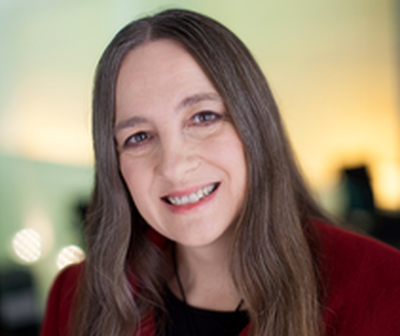 We are delighted to share that COAH Core Faculty member Dr. Karen Bandeen-Roche has been named our 2024 Champion. She is a Professor and Emeritus Chair of the Department of Biostatistics at the Bloomberg School of Public Health. Also, Dr. Bandeen-Roche holds joint appointments in Medicine and Nursing. Dr. Bandeen-Roche’s research focuses on biostatistics and aging. Her career’s mission is to create statistical reasoning needed to learn how we can lengthen healthy life and increase independence for older adults, with special interests in physical frailty, resilience and cognitive dysfunction. To this purpose, Dr. Bandeen-Roche’s methodological research includes latent variable models, longitudinal data analysis, and multivariate survival analysis.
We are delighted to share that COAH Core Faculty member Dr. Karen Bandeen-Roche has been named our 2024 Champion. She is a Professor and Emeritus Chair of the Department of Biostatistics at the Bloomberg School of Public Health. Also, Dr. Bandeen-Roche holds joint appointments in Medicine and Nursing. Dr. Bandeen-Roche’s research focuses on biostatistics and aging. Her career’s mission is to create statistical reasoning needed to learn how we can lengthen healthy life and increase independence for older adults, with special interests in physical frailty, resilience and cognitive dysfunction. To this purpose, Dr. Bandeen-Roche’s methodological research includes latent variable models, longitudinal data analysis, and multivariate survival analysis.
Beyond contributing to COAH as Core Faculty, Dr. Bandeen-Roche has several leadership roles at Johns Hopkins University, including serving as Co-Director of our Claude D. Pepper Older Americans Independence Center (OAIC), Data Core Leader with the Johns Hopkins Alzheimer’s Disease Research Center, Co-Director of our Frailty Science team, and Deputy Director with the Institute for Clinical & Translational Research, where she leads the Biostatistics and Research Design Program. Plus, she directs Hopkins’ Epidemiology and Biostatistics in Aging (EBA) T32 Training Program. Additionally, she serves on the Leadership Committee of the National OAIC Coordinating Center. And at one point in time, Dr. Bandeen-Roche served as the Interim Director for COAH. In fact, she has been a true champion of COAH since our beginning.
We are grateful to her for taking the time to be interviewed for this Summer 2024 COAH Champion feature story.
Tony Teano: Congratulations upon being named COAH’s Summer 2024 Champion! Please tell us about your background, education, and path to COAH.
Dr. Bandeen-Roche: I originate as a serious math geek—the kind whose leisure activities included calculating square roots by hand for fun. This continued through an undergraduate degree in mathematics—but by then I wished for a life activity with more immediate benefit for life on earth than to derive theorems. I sought an applied math field for graduate school—pursuing Operations Research and Industrial Engineering (ORIE) at Cornell, but soon discovered that statistics fascinated me a lot more than any of the other ORIE disciplines. I landed in Biostatistics because Johns Hopkins offered the most vibrant science/statistics interface—by far—among the several statistics and biostatistics faculty positions I was offered as I concluded my doctoral degree. This was 1990.
I stumbled upon aging much as I stumbled upon statistics. Scott Zeger walked me around to meet his research collaborators soon after I arrived at JHU: Two of them were Sheila West and Linda Fried. I was attracted to collaborate with them, first, because their personalities were inviting and their work fit within my interest of complex measurement problems, but before long, I was compelled by the vast opportunity aging science offered to benefit people. Once lit, this fire has never dimmed.
I can say truly that my path to COAH was at the very start of the road. I was a member of the 1997 JHU-wide committee that recognized aging as a major concern and opportunity for Johns Hopkins, and declared that a Center on Aging should be established. I’d already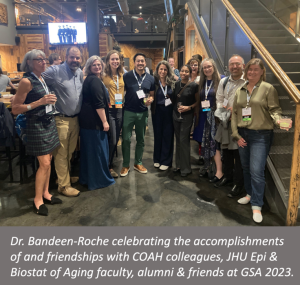 contributed to the Women’s Health and Aging Study and led in the statistical design of the Women’s Health and Aging Study II—pillars of COAH at its beginning. I led the first COAH Biostatistics Core. When Linda left to become the Columbia School of Public Health Dean in 2008, I was appointed as the Interim Director of COAH—a role I held for four years. I would have loved to direct the Center fully, but by then I was the Biostatistics chair, and I considered it not fair to either role to attempt it.
contributed to the Women’s Health and Aging Study and led in the statistical design of the Women’s Health and Aging Study II—pillars of COAH at its beginning. I led the first COAH Biostatistics Core. When Linda left to become the Columbia School of Public Health Dean in 2008, I was appointed as the Interim Director of COAH—a role I held for four years. I would have loved to direct the Center fully, but by then I was the Biostatistics chair, and I considered it not fair to either role to attempt it.
COAH is important in so many ways. It was the University’s first stake—and remains one of the most important—that it’s worth building an interdivisional presence on aging. It leverages the synergies that only can arise in this way. It has an important visioning role for the most important research we can accomplish together, and a key role in establishing bridges and communication pathways across units, disciplines and programs. May it flourish in all these regards and more.
Tony Teano: The purpose of this interview is to learn more about you both as a professional as well as a person. Let’s start with your research. What papers are you most known for or most proud of?
Dr. Bandeen-Roche: I would say there are three papers. In statistics, it’s my paper demonstrating that the specific distributional assumptions of latent variable models can be checked, and how to do it. This debunked a major, mistaken common wisdom about these models. Here’s the reference: Bandeen-Roche, K., Miglioretti, D. L., Zeger, S. L., & Rathouz, P. J. (1997). Latent Variable Regression for Multiple Discrete Outcomes. Journal of the American Statistical Association, 92(440), 1375–1386. https://doi.org/10.2307/2965407 A more accessible link can be accessed with Johns Hopkins credentials here.
Gerontologically, there are two papers addressing frailty. Here’s the reference for the first: Bandeen-Roche K, Xue QL, Ferrucci L, Walston J, Guralnik JM, Chaves P, Zeger SL, Fried LP. Phenotype of frailty: characterization in the women’s health and aging studies. J Gerontol A Biol Sci Med Sci. 2006 Mar;61(3):262-6. doi: 10.1093/gerona/61.3.262. PMID: 16567375. This was the first paper, to my knowledge, to attempt a construct validation of frailty (as opposed to content and predictive validation). Physical frailty phenotype measures were shown to behave consistently with a critical mass syndrome, as theorized, using latent class analysis. In the years since, construct validation of frailty measures has become more common. These don’t always agree with my substantive findings, but that’s fine—to pursue this important type of investigation is the thing!
The second gerontological paper to which I am referring established nationally representative estimates of frailty prevalence in the US – an important benchmark in its own right. It also evidenced stunningly large disparities in frailty prevalence for historically under-represented racial/ethnic groups, laying foundation for further research to better understand why and how this might be addressed. Here’s its reference: Bandeen-Roche K, Seplaki CL, Huang J, Buta B, Kalyani RR, Varadhan R, Xue QL, Walston JD, Kasper JD. Frailty in Older Adults: A Nationally Representative Profile in the United States. J Gerontol A Biol Sci Med Sci. 2015 Nov;70(11):1427-34. doi: 10.1093/gerona/glv133. Epub 2015 Aug 21. PMID: 26297656; PMCID: PMC4723664.
Tony Teano: You recently stepped down from your role as Chair of BSPH/Biostatistics. What were you proud to have accomplished during your time as chair?
Dr. Bandeen-Roche: I’m proud to have helped the department navigate a difficult time as I was taking on the role and then to strengthen its promise to advance science through statistics by broadening its tent of expertise. We now span the whole spectrum from theory to practice and from modeling to data science both as a faculty and in our educational programs. I think we achieved it while maintaining and growing respect for one another. We also have upheld a culture of mutual caring and supportiveness that we believe fosters risk taking and creativity, in addition to enhancing life quality.
Tony Teano: What have you been doing with your additional time since you stepped down?
Dr. Bandeen-Roche: I began by teaching more than usual—rewarding, but not the optimal choice for transitioning. Since my teaching for the year ended, though, I’ve been spending more time in research—everything from thinking to planning to analyzing data, and loving it. The email and meeting time has dropped significantly, and I celebrate this!
Tony Teano: These are major transitions. How do you navigate and prepare for change, either at work or in life in general?
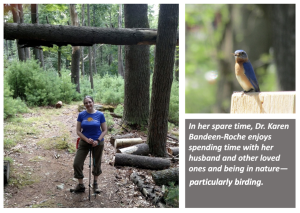 Dr. Bandeen-Roche: This is a tough question. Change can be hard particularly because it may come unexpectedly. One key to navigating, then, is to maintain an even keel, and this in turn requires self-care, developing ability to maintain perspective, and remembering that changes present opportunity.
Dr. Bandeen-Roche: This is a tough question. Change can be hard particularly because it may come unexpectedly. One key to navigating, then, is to maintain an even keel, and this in turn requires self-care, developing ability to maintain perspective, and remembering that changes present opportunity.
One more specific answer is to create reserve (and hence resilience) to meet change—by ensuring personnel and resource buffers, for example. Another is to keep one’s (personal or organizational) portfolio diversified. Yet one more is to emphasize assets above specific foci. In biostatistics, for example, data science is huge now, but ten years ago it was genomics, and another 10 years before that it was computational statistics, and before that it was modeling for complex data. 10 years from now it may be something else entirely! As long as one has faculty who are intellectually curious, broadly knowledgeable about fundamentals of statistical ideas and practice, span the gamut of strengths from basic knowledge to detailed application, and like each other/work well together, we can pivot to take on whatever comes next.
Tony Teano: Work/Life balance is related to creating reserve. What you do to unwind, such as hobbies or interests you enjoy? What renews you?
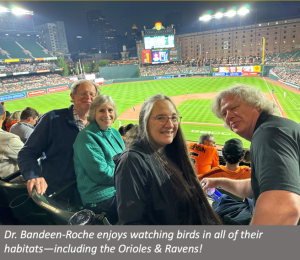 Dr. Bandeen-Roche: Being with my husband and other loved ones (including our dogs when we have them—are currently in between…), being in nature—particularly birding… reading… losing myself in sports events involving the teams I care about – the Orioles; various Maryland Terrapin college teams; the Ravens.
Dr. Bandeen-Roche: Being with my husband and other loved ones (including our dogs when we have them—are currently in between…), being in nature—particularly birding… reading… losing myself in sports events involving the teams I care about – the Orioles; various Maryland Terrapin college teams; the Ravens.
Tony Teano: Tell us more about what in pop culture you escape into—a few of your favorite things.
Dr. Bandeen-Roche: Here’s the short list.
Favorite performer: Rush (the Canadian rock band). The Tragically Hip (another Canadian rock band) is a close second.
Favorite TV show: Probably “Scrubs” for a long-running series; Slings and Arrows (three-year mini-series about a Shakespeare Festival troupe) overall.
Daytrip getaway destination: DC, as I love the Smithsonian. An “everyday” getaway is the Font Hill Wetland Park, just two miles from my home. 
Tony Teano: If you could go anywhere in the world, what place would you like to visit and why?
Dr. Bandeen-Roche: Scotland; land of my forebears. Best trip of my life was here (1999), and I’d love to return. Never yet seen but bucket list includes the Apostle Islands (northern Wisconsin) and UP of Michigan, and Nova Scotia.
Tony Teano: As we wrap up this interview, please share the best advice, personal or professional, you have ever received.
Dr. Bandeen-Roche: Two items:
(1) From my PhD advisor, Dr. David Ruppert: Remember that it’s a marketplace of ideas. It doesn’t matter how good your ideas are if you can’t sell them to the key stakeholders (scientific community… institutional leaders… policymakers… the public).
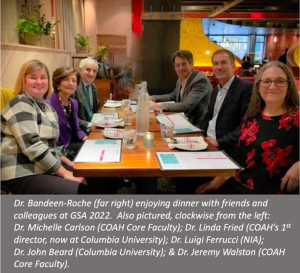 (2) From Dr. Linda Fried (former COAH director): Sit at the table. This means placing oneself in the middle of discussions that matter (as opposed to the sidelines or the perimeter of the room), and then contributing to them robustly (as opposed to observing or only responding in narrow areas one considers one’s purview). Fortunately, Linda welcomed everyone to the table who wanted to be there. As a statistician, this changed my life. I would never have become a gerontologist otherwise.
(2) From Dr. Linda Fried (former COAH director): Sit at the table. This means placing oneself in the middle of discussions that matter (as opposed to the sidelines or the perimeter of the room), and then contributing to them robustly (as opposed to observing or only responding in narrow areas one considers one’s purview). Fortunately, Linda welcomed everyone to the table who wanted to be there. As a statistician, this changed my life. I would never have become a gerontologist otherwise.
By: Anthony Teano, MLA
Communications Specialist
